‘Infrathin’: Exploring existence through art
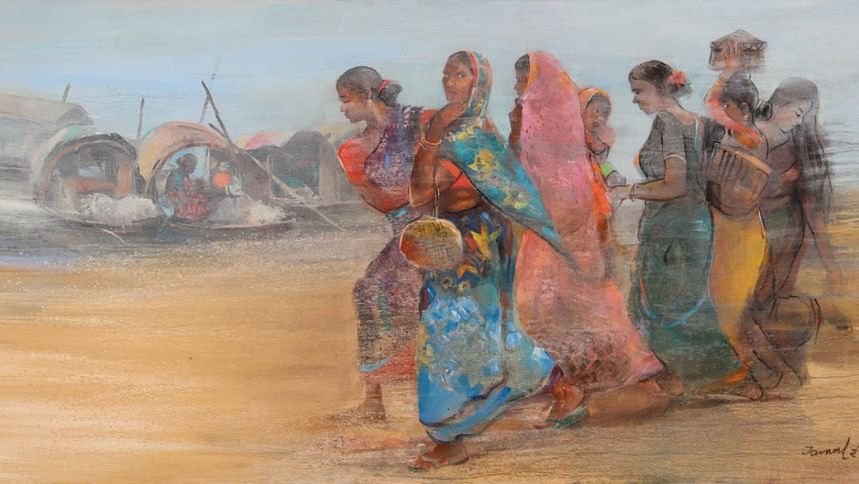
Before words, before language, comes sight. It is through our eyes that we encounter the world after being born, forming the bedrock of our conscious understanding. Yet, John Berger argued in his book "Ways of Seeing" that this initial encounter is far from pure. Our perception is sculpted by the invisible hand of power, by the social and cultural context that filters and shapes what we see. A painting, for instance, is not merely a canvas and pigments; it's a social document, a reflection of the hierarchies and ideologies of its time.
On that note, Edge, The Foundation, acts as the catalyst, uniting 15 previously featured artists— Tajuddin Ahmed, Jamal Ahmed, Mohammad Eunus, Anisuzzaman Anis, Mohammad Iqbal, Tejosh Halder Josh, Anukul Chandra Mojumder, Kanak Chanpa Chakma, Shambhu Acharya, Abdus Shakoor Shah, Golam Faruque Bebul, Azmeer Hossain, Rokeya Sultana, Md Tokon, and Maksuda Iqbal Nipa— to collectively create "Infrathin", a nuanced space that serves as the conduit for their artistic logics, resonating with the complexities of the unseen and the societal context.
In the collaborative embrace of "Infrathin", the artists channel their creative energies, forming a cohesive vessel that not only captivates but also reflects the significance of the world around us. "The works of 15 featured artists are different in styles. It was quite challenging to bring them under the same roof with an umbrella theme," says the curator of the show, Mustafa Zaman, a Dhaka-based artist, critic, and curator.
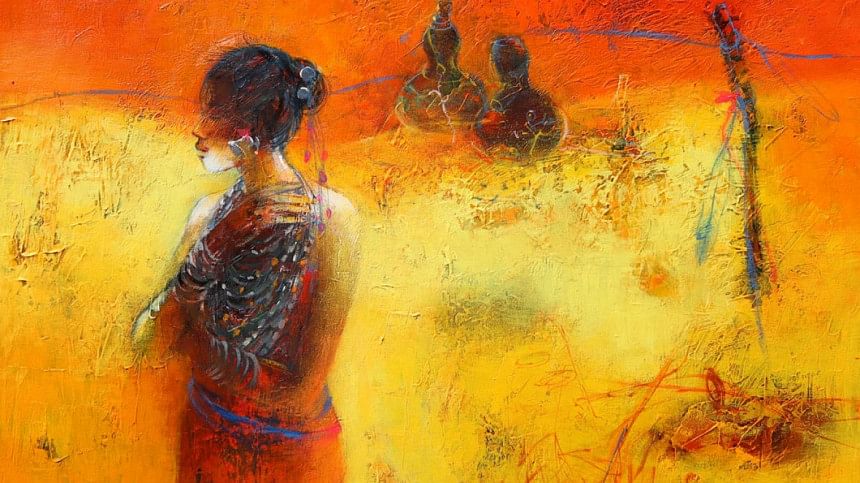
Marcel Duchamp once used the term 'infrathin' to point to the minuscule difference, temporal as well as spatial, between an object and an artwork. Art becomes an object of social aesthetic significance because of this difference. 'Sensitivity to difference' is central to the idea of Infrathin where 15 prolific artists belonging to different generations unite to advance a symphony made out of individual notes.
What makes an artwork great may sometimes elude us. But one realises that all great artworks transcend the limits of space and time. One is also aware that they are the result of visions that seek to capture the totality, or the whole. Infrathin is therefore an attempt to look at the big picture from a specific point in time and space.
Tajuddin Ahmed's paintings of the past two decades bring forth a mixture of visual imagery, signalling a life lived between two different metropolises— Dhaka, his birthplace, and Toronto, his adopted home. The hints of Laxmibazar, the sounds, and sights of its bustling streets and labyrinthine alleys seem to come to the surface as the painter continues to paint to recall his past. Tajuddin scripts the 'present' with some obvious references to both actual and virtual places since some of the developments in the abstract movement in Bangladesh found their way into his language of expression.
Jamal Ahmed's works— especially those that act as a window to the world, either drenched in rain, or kissed by the wind— are at odds with the naturalists who paint to advance a socio-political narrative. There are visual effects that are unique to his works achieved through a rapid process of laying down the final layer of paint. This leaves on the surface some signature texture, or at times a faint fogginess, adding to the expressiveness of each image and making his works all the more comparable to the expressionists who prioritise essence over representation.
Abstraction thrived as a distinct idiom in Bangladesh and Mohammad Eunus clearly has a stake in it. What he achieved as an artist in the past four decades or so can be summed up in his effort to not appeal to taste but to create aesthetic properties that provoke aesthetic evaluation. Therefore, by placing the aesthetic over taste, Mohammad Eunus has refashioned abstraction to suit his purpose. As a consequence, he has become one of its most memorable exponents. For his unique language of expression, he now occupies a special place in the mantle of creativity.
Anisuzzaman Anis's scheme demands meticulous attention to lines. In fact, lines set off the skillfully-arrived composition in every work. The ability to achieve an optimal quality by using only a few plates is the most necessary skill when one is using the relief method. As a printmaker par-excellence, Anis has demonstrated time and again that precision plays off when this method is brought to bear on images changing urban environments rendered to appeal to the urbane taste buds.
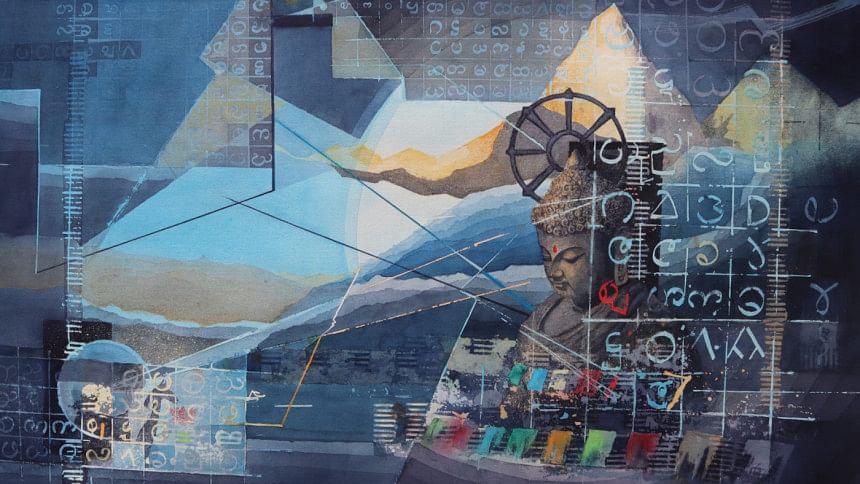
Most of Mohammad Iqbal's paintings are populated by children and women who stare at the viewers from within the enclosed space of each canvas. They represent the multitude living under the shadow of fear. Their poignant eyes and doleful faces bore the signs of conflict, pogrom, and the terror of living in a deeply polarised world.
For Tejosh Halder Josh, the body is the primary location from which all experiences are aroused. The sculptor believes that the presence of the body can never be discounted even when one is working on a form to express formal rigour. The human body is not merely a form; it is part of the universe, and life is a way to come to understand the connection between the microcosm of the body and the macrocosmic reality that is the cosmos.
Anukul Chandra Mojumder is aware that the content he has in mind cannot be framed as an 'image-object.' Therefore, he harnesses various landscapes— like images are the traces of the felt community. One can hear the echo of his childhood and the desires attendant to the life he once experienced when growing up.
Kanak Chanpa Chakma is an artist whose paintings have always rested at the intersection of art history and cultural identity; she has brought forth her community's collective ethos through her works fraught with references to life in the hills of Chattogram. She has been employing a language of expression that connects her to the development of modern painting in Bangladesh. Yet she has unswervingly stayed attached to her roots.
Shambhu Acharya is well known for his Gazi pata. But he has also been portraying the legends of Shree Krishna, Ramayana, Mahabharata, Manasha Mangal, besides the festival of Muharram, Raas Leela, and various other folklores.
Abdus Shakoor Shah has developed a distinctive style variously drawing from the tales of Mymensingh Geetika (the ballads of Mymensingh). He began to negotiate traditional patachitra or paintings on clothes in his own terms as he started to appropriate the compositional scheme of the patachitras, playfully bringing into alignment text and image. The portrayal of literary protagonists in reference to folklore places Shakoor in a unique position as he continues to revisit "Mahua" and "Malua" love stories, or "Nakshi Kanthar Maath" by Pallikabi Jasimuddin. These folklores are decoded and turned into motifs of 'shared aesthetics' in Shakoor's hand.
One redeeming feature in the language of the late artist Golam Faruque Bebul is his use of motifs and colours, which portray rural Bangladesh, connecting the interiority of his artwork to its exteriority.
Azmeer Hossain's abstract cityscapes evoke a sense of distance and memory, while Rokeya Sultana's paintings address femininity and cosmicity. Md Tokon aims to capture fleeting moments of reality through his expressive works, while Maksuda Iqbal Nipa's colourful paintings explore themes of emotion and struggle.
The exhibition, inaugurated on February 24, will run until April 6 at Edge Gallery in Gulshan. The event is open for all from 10am to 8pm.

 For all latest news, follow The Daily Star's Google News channel.
For all latest news, follow The Daily Star's Google News channel. 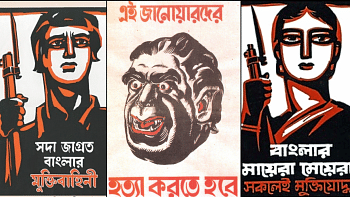



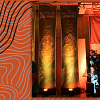
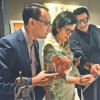
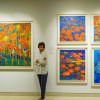
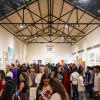


Comments